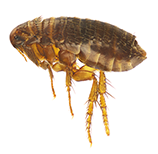Overview
There are many types of tapeworms that can affect dogs, even some that can cause deadly disease and infect people. Luckily, by far the most common type, Dipylidium caninum, is basically harmless to your pooch and of no worry to you. The following article concerns this common type of tapeworm, which can sometimes live in your dog’s small intestine -- feeding off the food she eats as it makes its way through her digestive system.
It's totally disgusting to think that in the early 1900s, it was vogue to consume tapeworms as an easy means of weight loss.
So, what exactly is a tapeworm? Tapeworms get their name from the fact that they look like — you guessed it — tape. The body of the tapeworm is segmented up to its neck. Its mouth is filled with six sets of teeth that the parasite uses to attach itself to the intestinal lining. Once it’s attached, it moves in permanently and starts stealing its meals from your pooch.
How does a dog get tapeworms?
So here's where tapeworms get even freakier.  Tapeworms are usually transmitted when a dog digests a flea during grooming. Dogs can also get tapeworms by ingesting the eggs shed by other animals or by hunting flea-infested rodents. As mentioned, a tapeworm’s body is made up of tiny segments. Each of these segments has its own digestive and reproductive system. These segments eventually break off and are passed through your dog’s digestive system, exiting via the anus.
Tapeworms are usually transmitted when a dog digests a flea during grooming. Dogs can also get tapeworms by ingesting the eggs shed by other animals or by hunting flea-infested rodents. As mentioned, a tapeworm’s body is made up of tiny segments. Each of these segments has its own digestive and reproductive system. These segments eventually break off and are passed through your dog’s digestive system, exiting via the anus.
These nasty segments, which look like pieces of rice, are spread around the house and can be found on your furniture and in your carpeting. When a segment is ingested by a host, the cycle can start all over again, inside the unknowing victim’s digestive tract.
Symptoms
The most common symptom of tapeworms is the appearance of the tapeworm segments on your dog’s fur -- near her anus or in her stool. Because tapeworms feed on the nutrients passed in the small intestine, your dog may seem more hungry than usual as she is unwittingly sharing her meals with a nasty intestinal parasite. If the infestation lasts long enough, your dog might even lose weight.
Diagnosis/Treatment
The easiest and most common way to diagnose tapeworms is through visual inspection. Your veterinarian may also recommend other diagnostic tests, depending on your dog’s symptoms; one such test may be a fecal test to rule out other intestinal parasites.
Treating tapeworms includes a deworming medication that will kill the existing tapeworms. Additionally, ensuring your pooch and house are flea-free is important, since your dog can become reinfested by consuming fleas.
Prevention of tapeworms includes keeping your dog’s bedding clean and your dog and house free of fleas. Use proper flea control, as recommended by your veterinarian, for the environment you live in. If your dog is a hunter, check her frequently as rodents are often hosts to fleas, which in turn are hosts to tapeworms!
If you have any questions or concerns, you should always visit or call your veterinarian – they are your best resource to ensure the health and well-being of your pets.
Beware the Bug By Dr. Ruth MacPete Fleas are extremely hardy and can jump over thirteen inches. Worst of all, they can transmit tapeworm. Read more> Or learn more about dogs and parasites > |

